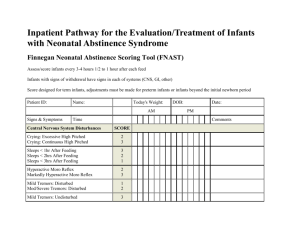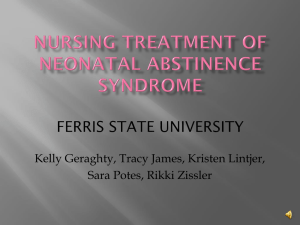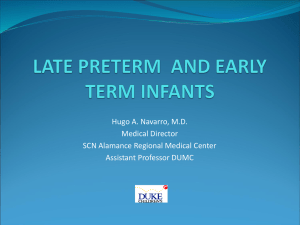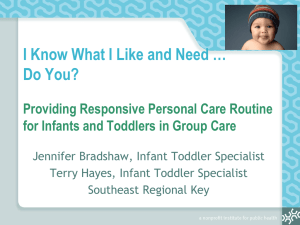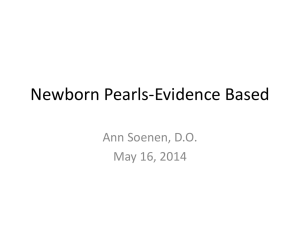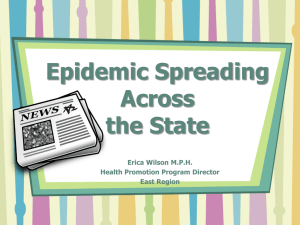PowerPoint Slides - The JAMA Network Journals
advertisement
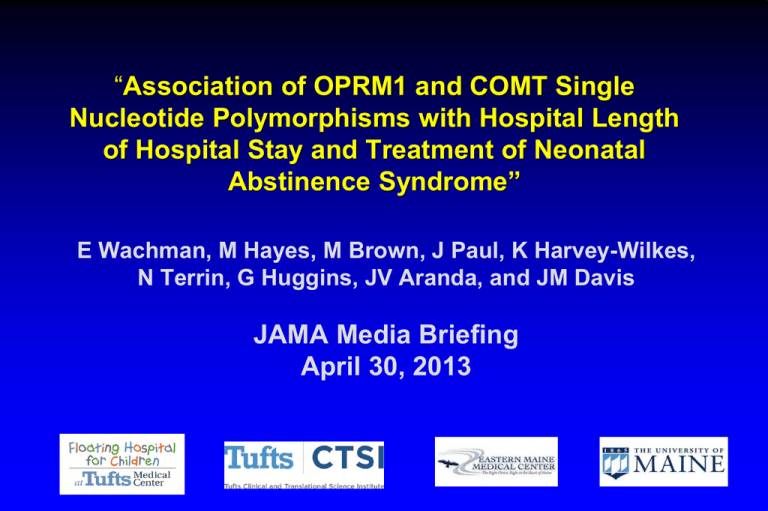
“Association of OPRM1 and COMT Single Nucleotide Polymorphisms with Hospital Length of Hospital Stay and Treatment of Neonatal Abstinence Syndrome” E Wachman, M Hayes, M Brown, J Paul, K Harvey-Wilkes, N Terrin, G Huggins, JV Aranda, and JM Davis JAMA Media Briefing April 30, 2013 Disclosures No Conflicts of Interest This study was supported in part by NIH funding: DA024806-01A2 to Dr. Marie Hayes and R01DA032889-01A1 to Dr. Jonathan Davis Neonatal Abstinence Syndrome • Opioid exposure in pregnancy - 5.6 infants/1,000 • • • • births Incidence has tripled in the past decade The mother may also be smoking or taking other medications Signs of withdrawal in 60-80% of infants exposed to opioids Dysfunction of the central nervous system, gastrointestinal tract, and/or respiratory system Neonatal Abstinence Syndrome • Prolonged treatment in hospital, high healthcare costs • Safety and efficacy of agents not well established • Significant variability in the incidence and severity • Factors influencing this variability are unknown Neonatal Abstinence Syndrome • • • • Genetic factors may be important Single nucleotide polymorphisms (SNPs): Single base pair changes that can alter protein’s function SNPs influence opioid dosing, metabolism, and addiction in adults No prior studies of genetic links to NAS Candidate Genes for NAS • SNPs present in 40-50% of the population have been studied in adults • Mu Opioid Receptor (OPRM1) = Site of Action • 118A>G SNP • Multi-Drug Resistance Gene (ABCB1) = Transporter • 1236C>T SNP • 3435C>T SNP • 2677G/T/A SNP • Catechol-O-methyltransferase (COMT) = Modulator • 158A>G SNP Objective • Do SNPs in the OPRM1, ABCB1, and/or COMT genes influence length of hospital stay (LOS) and need for treatment in infants exposed to opioids during pregnancy • Outcome Measures: • Primary: Length of hospital stay • Secondary: Treatment for NAS, need for multiple medications Methods • • • • • • 86 opioid exposed term infants Mothers receiving methadone or buprenorphine Infants treated with morphine or methadone If severe - additional medications given A sample of blood or saliva collected from each infant Incidence and severity correlated with changes in genetic profiles Results DEMOGRAPHICS White 98% Maternal Methadone 64% Maternal Buprenorphine 36% Maternal Smoking 78% Maternal Benzodiazepines 12% LOS All Infants Mean 22.3 days LOS Treated Infants Mean 31.6 days Treatment for NAS 65% Treated with >2 medications 24% OPRM1 118A>G Results • • AA vs AG/GG infants compared in models that adjust for breastfeeding and study site Those with the AG/GG genotype - treated less frequently and had shorter LOS OUTCOME UNADJUSTED RESULTS ADJUSTED RESULTS P-VALUE Infant Treated 72% vs 48% OR = 0.76 (CI 0.63, 0.96) 0.006 Mean LOS 24.1 vs 17.6 days - 8.5 days 0.009 COMT 158A>G Results • • AA infants vs AG/GG infants in models that adjusted for breastfeeding and site AG/GG infants were treated less frequently and had shorter LOS than AA infants OUTCOME UNADJUSTED RESULTS ADJUSTED RESULTS P-VALUE Infant Treated 88% vs 60% OR = 0.79 (CI 0.61, 0.99) 0.02 Mean LOS 31.1 vs 20.4 days - 10.8 days 0.005 Conclusions • NAS is a complex disorder with many factors contributing to the incidence and severity • SNPs in the OPRM1 and COMT genes - reduced treatment and LOS • No associations found with ABCB1 SNPs • Combining clinical risk factors with genetic profiling would permit personalized genetic medicine and targeted treatment regimens Challenges in Neonatal Drug Development • Most drugs used in newborn infants not FDA • • • • approved - safety and efficacy not established Small market, high liability, ethical concerns Significant variability in NAS treatment protocols Many NAS medications include alcohol or propylene glycol Concern for adverse long-term developmental outcomes Future Directions • NIH Grant – “Improving Outcomes in Neonatal Abstinence Syndrome” • Randomize infants to receive morphine or methadone (determine best practice) • Evaluate long-term neurodevelopmental outcomes of infants treated for NAS • Establish other genetic factors - Addiction Array (1350 SNPs for addiction disorders) Acknowledgements • The Floating Hospital at Tufts Medical Center: • Tufts Medical Center, Melrose Wakefield Hospital, Brockton Hospital, and Lowell General Hospital • Ozlem Kasaroglu, Teresa Marino, Mario Cordova • CTRC Genomics Laboratory • Eastern Maine Medical Center: • Staff at the EMMC • Hira Shrestha; Nicole Heller, Beth Logan, Deborah Morrison That’s All Folks!
